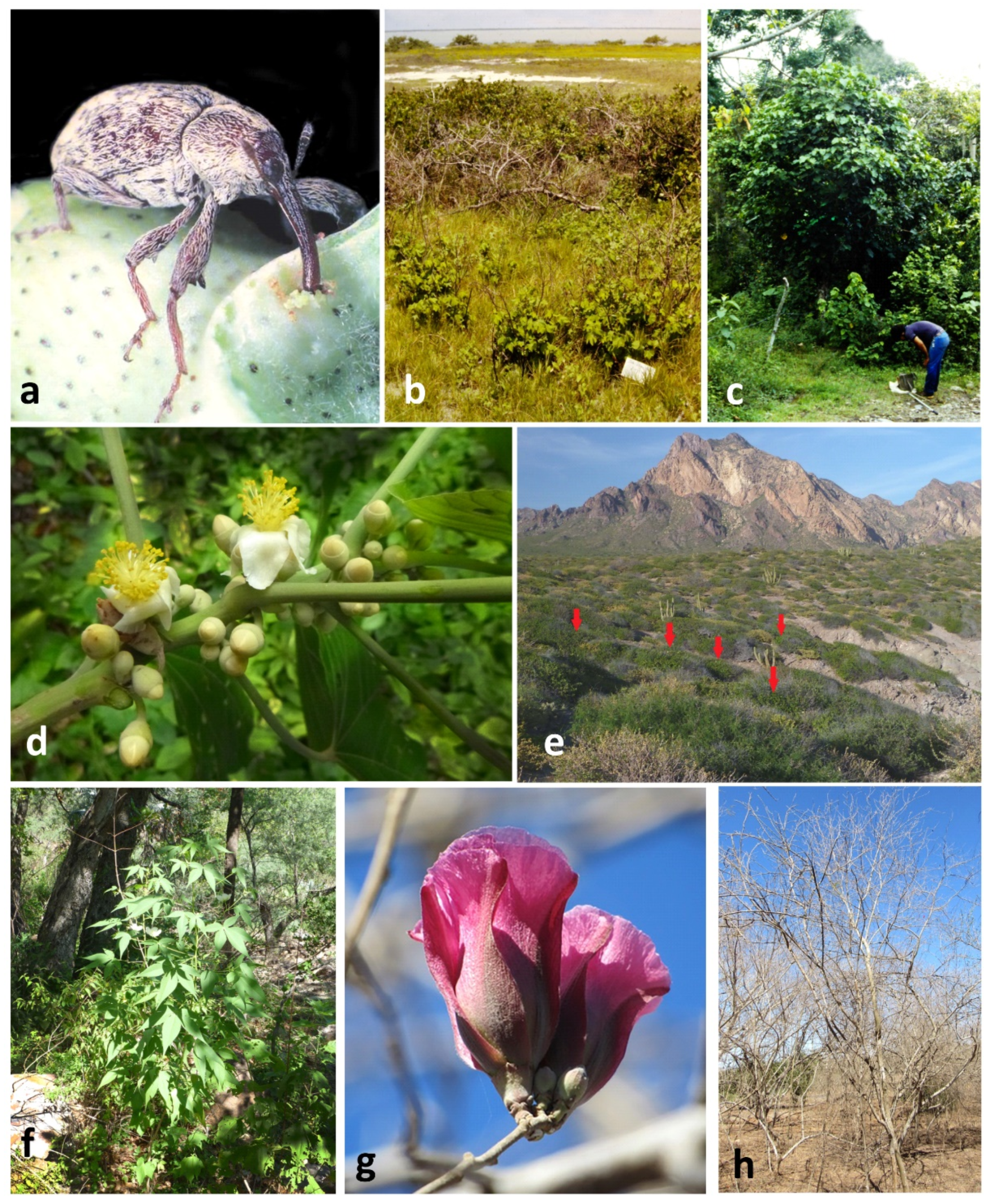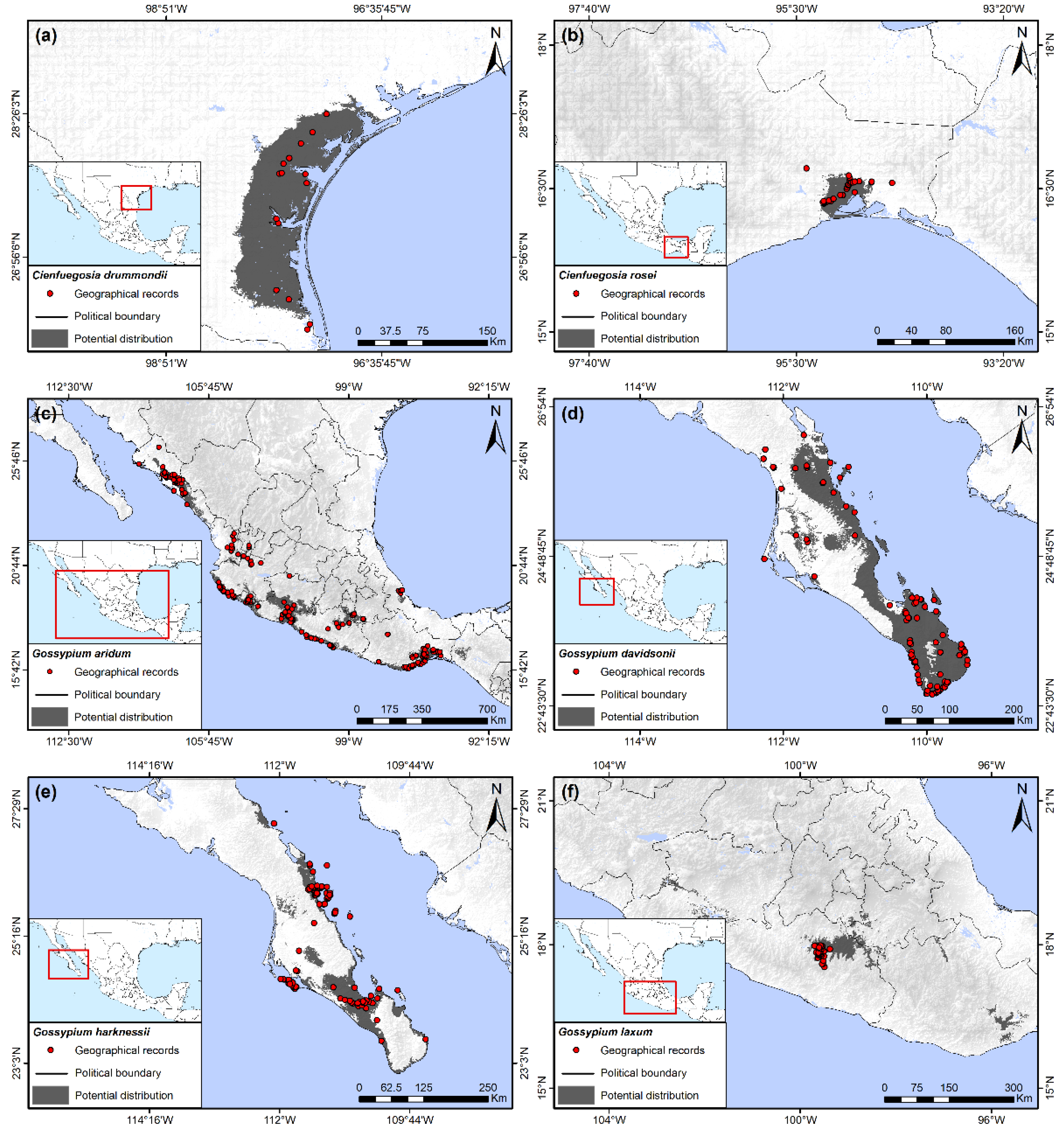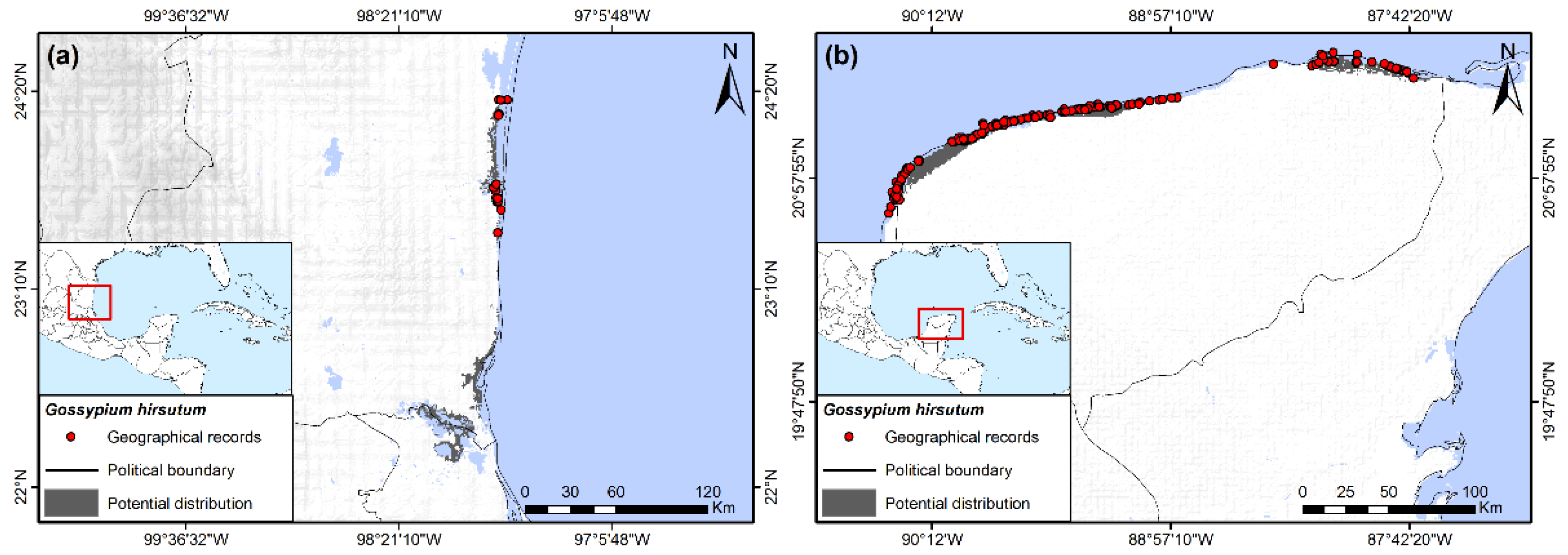Potential Distribution of Wild Host Plants of the Boll Weevil (Anthonomus grandis) in the United States and Mexico
Abstract
Simple Summary
Abstract
1. Introduction
2. Materials and Methods
2.1. Selection of Plant Species Considered as Valid Wild Host Plants of Boll Weevil
2.2. Geographical Records
2.3. Environmental Variables
2.4. Niche Modelling
3. Results
3.1. Cienfuegosia drummondii (A. Gray) Lewton
3.2. Cienfuegosia rosei Fryxell
3.3. Gossypium aridum (Rose & Standl.) Skovst
3.4. Gossypium davidsonii Kellogg
3.5. Gossypium harknessii Brandegee
3.6. Gossypium laxum L. Phillips
3.7. Gossypium hirsutum L.
3.8. Gossypium lobatum H. Gentry
3.9. Gossypium thurberi Todara
3.10. Gossypium turneri Fryxell
3.11. Hampea latifolia Standley
3.12. Hampea nutricia Fryxell
3.13. Hampea rovirosae Standley
4. Discussion
5. Conclusions
Author Contributions
Funding
Institutional Review Board Statement
Informed Consent Statement
Data Availability Statement
Acknowledgments
Conflicts of Interest
References
- Hajjar, R.; Hodgkin, T. The use of wild relatives in crop improvement: A survey of developments over the last 20 years. Euphytica 2007, 156, 1–13. [Google Scholar] [CrossRef]
- Ford-Lloyd, B.V.; Schmidt, M.; Armstrong, S.J.; Barazani, O.Z.; Engels, J.; Hadas, R.; Hammer, K.; Kell, S.P.; Kang, D.; Khoshbakht, K.; et al. Crop wild relatives—undervalued, underutilized and under threat? BioScience 2011, 61, 559–565. [Google Scholar] [CrossRef]
- Branson, T.F.; Krysan, J.L. Feeding and oviposition behavior and life cycle strategies of Diabrotica: An evolutionary view with implications for pest management. Environ. Entomol. 1981, 10, 826–831. [Google Scholar] [CrossRef]
- Burke, H.R.; Clark, W.E.; Cate, J.R.; Fryxell, P.A. Origin and dispersal of the boll weevil. Bull. Entomol. Soc. Am. 1986, 32, 228–238. [Google Scholar] [CrossRef]
- Jones, R.W. Evolution of the host plant associations of the Anthonomus grandis species group (Coleoptera: Curculionidae): Phylogenetic tests of various hypotheses. Ann. Entomol. Soc. Am. 2001, 94, 51–58. [Google Scholar] [CrossRef]
- Bernal, J.S.; Medina, R.F. Agriculture shows pests: How crop domestication, host shifts, and agricultural intensification can create insect pests from herbivores. Curr. Opin. Insect Sci. 2018, 26, 76–81. [Google Scholar] [CrossRef]
- Bernal, J.S.; Dávila-Flores, A.M.; Medina, R.F.; Chen, Y.H.; Harrison, K.E.; Berrier, K.A. Did maize domestication and early spread mediate the population genetics of corn leafhopper? Insect Sci. 2019, 26, 569–586. [Google Scholar] [CrossRef]
- Chen, Y.H. Crop domestication, global human-mediated migration, and the unresolved role of geography in pest control. Elem. Sci. Anthr. 2016, 4, 1–13. [Google Scholar] [CrossRef]
- Ramalho, F.S.; Wanderley, P.A. Ecology and management of the boll weevil in South American cotton. Am. Entomol. 1996, 42, 41–47. [Google Scholar] [CrossRef]
- Stadler, T.; Buteler, M. Migration and dispersal of Anthonomus grandis (Coleoptera: Curculionidae) in South America. Rev. De La Soc. Entomológica Argent. 2007, 66, 205–217. [Google Scholar]
- TBWEP. Texas Boll Weevil Eradication Program. Maintenance Area Information. 2021. Available online: https://www.txbollweevil.org/tma.html (accessed on 29 December 2021).
- Raszick, T.J.; Dickens, C.M.; Perkin, L.C.; Tessnow, A.E.; Suh, C.P.C.; Ruiz-Arce, R.; Boratynski, T.N.; Falco, M.R.; Johnston, J.S.; Sword, G.A. Population genomics and phylogeography of the boll weevil, Anthonomus grandis Boheman (Coleoptera: Curculionidae), in the United States, northern Mexico, and Argentina. Evol. Appl. 2021, 14, 1778–1793. [Google Scholar] [CrossRef] [PubMed]
- Vázquez, J.N. Breve historia del picudo del algodonero en México y de los métodos empleados para su control. Vedalia 1998, 5, 61–70. [Google Scholar]
- Ulloa, M. The diploid D genome cottons (Gossypium spp.) of the New World. In World Cotton Germplasm Resources; Abdurakhmonov, I.Y., Ed.; IntechOpen: London, UK, 2014; pp. 203–229. [Google Scholar] [CrossRef]
- Jones, R.W.; Cruz-Torres, M.F.; López-González, C.; Duarte-Fernández, M.A. Conservation status the genus Hampea (Malvaceae: Gossypieae) in Mexico. Bot. Sci. 2018, 96, 426–442. [Google Scholar] [CrossRef]
- GFW, Global Forest Watch. Mexico Deforestation Rates. Available online: https://www.globalforestwatch.org/ (accessed on 11 January 2022).
- Rosete-Vergés, F.A.; Pérez-Damián, J.L.; Villalobos-Delgado, M.; Navarro-Salas, E.N.; Salinas-Chávez, E.; Remond-Noa, R. El avance de la deforestación en México 1976–2007. Madera Y Bosques 2014, 20, 21–35. [Google Scholar] [CrossRef]
- Cross, W.H.; Lukefahr, M.J.; Fryxell, P.A.; Burke, H.R. Host plants of the boll weevil. Environ. Entomol. 1975, 4, 19–26. [Google Scholar] [CrossRef]
- Stansly, P.A. Life History and Ecology of the Boll Weevil on a Native Host Plant in Southeastern Mexico. Ph.D. Thesis, Texas A&M University, College Station, TX, USA, 1985. Available online: https://hdl.handle.net/1969.1/DISSERTATIONS-446669 (accessed on 11 January 2022).
- Cate, J.R.; Krauter, P.C.; Godfrey, K.E. Pests of cotton. In Classical Biological Control in the Southern United States; Habeck, D.H., Bennett, F.D., Frank, J.H., Eds.; Southern Cooperative Series Bulletin (USA). No. 355, 1990; Agricultural Research Service: Fort Pierce, FL, USA; pp. 17–29.
- Jones, R.W. Ecology and Evolution of the Boll Weevil Complex, (Anthonomus grandis group, Coleoptera: Curculionidae) and their Hampea Host Plants. Ph.D. Thesis, Texas A&M University, College Station, TX, USA, 1994. [Google Scholar]
- Kuester, A.P.; Jones, R.W.; Sappington, T.W.; Kim, K.S.; Barr, N.B.; Roehrdanz, R.L.; Senechal, P.; Nason, J.D. Population structure and genetic diversity of the boll weevil (Coleoptera: Curculionidae) on Gossypium in North America. Ann. Entomol. Soc. Am. 2012, 105, 902–916. [Google Scholar] [CrossRef]
- Alvarado, A.; Jones, R.W.; Pedraza-Lara, C.; Alvarado-Villanueva, O.; Pfeiler, E. Reassessment of the phylogeography and intraspecific relationships of western and eastern populations of the boll weevil, Anthonomus grandis Boheman (Coleoptera: Curculionidae), in North America. Biol. J. Linn. Soc. 2017, 122, 29–45. [Google Scholar] [CrossRef]
- Burke, H.R.; Clark, W.E. Cienfuegosia drummondii as a host of the boll weevil, Anthonomus grandis, in South Texas. In Boll Weevil, Suppression, Management, and Elimination Technology; USDA-ARS-s-71: Memphis, TN, USA, 1976; pp. 12–21. [Google Scholar]
- Coad, B.R. Relation of the Arizona Wild Cotton Weevil to Cotton Plantings in the Arid West; no. 233; Bulletin of the U.S. Department of Agriculture: Washington, DC, USA, 1915. [Google Scholar] [CrossRef]
- NaturaLista, Mexico. Available online: https://www.inaturalist.org/photos/14644157 (accessed on 11 January 2022).
- NaturaLista, Mexico. Available online: https://www.inaturalist.org/photos/14644153 (accessed on 11 January 2022).
- Obregón-Arzaluz, I.; Jones, R.W. Ecology and phenology of the boll weevil (Coleoptera: Curculionidae) on an unusual wild host, Hibiscus pernambucensis, in Southeastern Mexico. J. Econ. Entomol. 2001, 94, 1405–1412. [Google Scholar] [CrossRef]
- d’Eeckenbrugge, G.C.; Lacape, J.M. Distribution and differentiation of wild, feral, and cultivated populations of perennial upland cotton (Gossypium hirsutum L.) in Mesoamerica and the Caribbean. PLoS ONE 2014, 9, e107458. [Google Scholar] [CrossRef]
- Fryxell, P.A. Malvaceae of México (Systematic Botany Monographs); The American Society of Plant Taxonomists: Ann Arbor, MI, USA, 1988; 522p. [Google Scholar]
- GBIF.org (Global Biodiversity Information Facility), GBIF Home Page. Available online: https://www.gbif.org (accessed on 1 September 2021).
- Fick, S.E.; Hijmans, R.J. Worldclim 2: New 1-km spatial resolution climate surfaces for global land areas. Int. J. Climatol. 2017, 37, 4302–4315. [Google Scholar] [CrossRef]
- Trabucco, A.; Zomer, R.J. Global Aridity Index and Potential Evapotranspiration (ET0) Climate Database v2. figshare. CGIAR Consort. Spat. Inf. 2018, 10, m9. [Google Scholar] [CrossRef]
- Hengl, T.; de-Jesus, J.M.; Heuvelink, G.B.M.; Gonzalez, M.R.; Kilibarda, M.; Blagotić, A.; Shangguan, W.; Wright, M.N.; Geng, X.; Bauer-Marschallinger, B.; et al. SoilGrids250m: Global gridded soil information based on machine learning. PLoS ONE 2017, 12, e0169748. [Google Scholar] [CrossRef] [PubMed]
- ESRI. ArcGIS Desktop: Versión 10.2.2; Environmental Systems Research Institute: Redlands, CA, USA, 2014. [Google Scholar]
- Ma, B.; Sun, J. Predicting the distribution of Stipa purpurea across the Tibetan Plateau via the Maxent model. BMC Ecol. 2018, 18, 10. [Google Scholar] [CrossRef] [PubMed]
- O’Donnell, M.S.; Ignizio, D.A. Bioclimatic predictors for supporting ecological applications in the conterminous United States. US Geol. Surv. Data Ser. 2012, 691, 4–9. [Google Scholar] [CrossRef]
- Middleton, N.; Thomas, D. World Atlas of Desertification, 2nd ed.; United Nations Environment Programme (UNEP): Great Britain, UK, 1997; p. 182. Available online: https://wedocs.unep.org/20.500.11822/30300 (accessed on 10 January 2022).
- Lodoño-Murcia, M.C.; Sánchez-Cordero, V. Distribución y conservación de especies amenazadas en Mesoamérica, Chocó y Andes tropicales. Rev. Mex. De Biodivers. 2011, 82, 926–950. [Google Scholar] [CrossRef]
- Phillips, S.J.; Anderson, R.P.; Schapire, R.E. Maximum entropy modeling of species geographic distributions. Ecol. Model. 2006, 190, 231–259. [Google Scholar] [CrossRef]
- Phillips, S.J.; Dudík, M. Modeling of species distributions with maxent: New extensions and a comprehensive evaluation. Ecography 2008, 31, 161–175. [Google Scholar] [CrossRef]
- Marmion, M.; Parviainen, M.; Luoto, M.; Heikkinen, R.K.; Thuiller, W. Evaluation of consensus methods in predictive species distribution modelling. Divers. Distrib. 2009, 15, 59–69. [Google Scholar] [CrossRef]
- Fryxell, P.A. Gossypium turneri (Malvaceae), a new species from Sonora, Mexico. Madroño 1978, 25, 155–159. Available online: https://www.jstor.org/stable/41424160 (accessed on 19 January 2022).
- Werner, F.G. A new character for the identification of the boll weevil and the thurberia weevil (Coleoptera: Curculionidae). Ann. Entomol. Soc. Am. 1960, 53, 548–549. [Google Scholar] [CrossRef]
- Fryxell, P.A.; Lukefahr, M.J. Hampea Schlecht: Possible primary host of the boll weevil. Science 1967, 155, 1568–1569. [Google Scholar] [CrossRef] [PubMed]
- ESA Common Names of Insects Database. Entomological Society of America. Available online: https://www.entsoc.org/common-names (accessed on 12 April 2020).
- Warner, R.E. Taxonomy of the subspecies of Anthonomus grandis (Coleoptera: Curculionidae). Ann. Entomol. Soc. Am. 1966, 59, 1073–1088. [Google Scholar] [CrossRef]
- Goodall-Copestake, W.P.; Tarling, G.A.; Murphy, E.J. On the comparison of population-level estimates of haplotype and nucleotide diversity: A case study using the gene cox1 in animals. Heredity 2012, 109, 50–56. [Google Scholar] [CrossRef] [PubMed]
- Choi, S.K.; Kim, K.S.; Lee, H.; Adamczyk, J.J.; Greenberg, S.M.; Westbrook, J.K.; Sappington, T.W. Temporal changes in genetic variation of boll weevil (Coleoptera: Curculionidae) populations, and implications for population assignment in eradication zones. Ann. Entomol. Soc. Am. 2011, 104, 816–825. [Google Scholar] [CrossRef][Green Version]
- Rodríguez-Vallejo, J. Íxcatl: El Algodón Mexicano; Sección de Obras de Antropología; Fondo de Cultura Económica: Mexico City, México, 1976; 95p. [Google Scholar]
- Carrillo-Rojas, A. Estudio introductorio. In Algodón en el Norte de México (1920–1970): Impactos Regionales de un Cultivo Estratégico; Cerutti, M., Almaraz, A., Eds.; El Colegio de la Frontera Norte, A.C.: Tijuana, México, 2013; pp. 11–36. [Google Scholar]
- Martins, W.F.S.; Ayres, C.F.J.; Lucena, W.A. Genetic diversity of Brazilian natural populations of Anthonomus grandis Boheman (Coleoptera: Curculionidae), the major cotton pest in the New World. Genet. Mol. Res. 2007, 6, 23–32. [Google Scholar] [PubMed]
- Marquesini, C.J.; Maggio, D.H.; Guedes, R.N.C.; Correa, A.S. Brazilian invasion and dispersion routes of the cotton boll weevil. J. Appl. Entomol. 2021, 46, 352–358. [Google Scholar] [CrossRef]
- Fryxell, P.A. The genus Hampea (Malvaceae). Brittonia 1969, 21, 359–396. [Google Scholar] [CrossRef]
- Stansly, P.A.; Cate, J.R. Discrimination by ovipositing boll weevils (Coleoptera: Curculionidae) against previously infested Hampea (Malvaceae) flower buds. Environ. Entomol. 1984, 13, 1361–1365. [Google Scholar] [CrossRef]
- Fryxell, P.A. The Natural History of the Cotton Tribe; Texas A&M University Press: College Station, TX, USA, 1979; 245p. [Google Scholar]
- Jones, R.W.; Cate, J.R.; Burke, H.R. Phenology and ecology of wild cotton (Malvales: Malvaceae) and the boll weevil (Coleoptera: Curculionidae) in Tamaulipas, Mexico. J. Econ. Entomol. 1989, 82, 1626–1632. [Google Scholar] [CrossRef]
- CONABIO. Comisión Nacional para el Conocimiento y Uso de la Biodiversidad. Biodiversidad Mexicana: Estudios. Estudios de Estados. Available online: https://www.biodiversidad.gob.mx/region/EEB/estudios (accessed on 1 December 2021).
- Jones, R.W.; Peruyero, D.B. Reproductive ecology of two species of the Anthonomus grandis species group (Coleoptera: Curculionidae) on Hampea (Malvaceae: Gossypieae) host plants in southern Mexico. Environ. Entomol. 2002, 31, 693–701. [Google Scholar] [CrossRef]
- Denlinger, D.L. Dormancy in tropical insects. Annu. Rev. Entomol. 1986, 31, 239–264. [Google Scholar] [CrossRef] [PubMed]
- Spurgeon, D.W.; Suh, C.P.C.; Esquivel, J.F. Diapause response of the boll weevil (Coleoptera: Curculionidae) to feeding period duration and cotton square size. J. Insect Sci. 2018, 18, 1. [Google Scholar] [CrossRef] [PubMed]
- Spurgeon, D.W.; Suh, C.P.C.; Esquivel, J.F. Diapause response of the boll weevil (Coleoptera: Curculionidae) to selected diets. J. Entomol. Sci. 2019, 54, 61–78. [Google Scholar] [CrossRef]
- Spurgeon, D.W.; Suh, C.P.C. Termination of diapause in the boll weevil (Coleoptera: Curculionidae). J. Econ. Entomol. 2019, 112, 633–643. [Google Scholar] [CrossRef] [PubMed]
- Inforural 2021. Reporte Anual de Producción de Algodón y Derivados. Available online: https://www.gob.mx/agricultura/articulos/el-algodon-de-mexico-fibra-suave-y-cultivo-generoso?idiom=es (accessed on 12 January 2022).
- USDA-Foreign Agricultural Service 2017. Commodity Intelligence Report. Available online: https://ipad.fas.usda.gov/highlights/2017/10/mexico/index.htm (accessed on 12 January 2022).
- Coleman, R.J.; Parker, R.D.; Darwe, D.L.; Mount, K. Potential of boll weevil reproduction on Cienfuegosia drummondii in South Texas. Proc. Beltwide Cotton Conf. 1999, 2, 889–891. [Google Scholar]
- Lewton, F.L. Cienfuegosia drummondii, a rare Texas plant. Bull. Torrey Bot. Club 1910, 37, 473–475. [Google Scholar] [CrossRef]
- Howe, R.W.; Davis, G.J.; Mosca, V. The demographic significance of ‘sink’ populations. Biol. Conserv. 1991, 57, 239–255. [Google Scholar] [CrossRef]
- SEMARNAT (Secretaría del Medio Ambiente y Recursos Naturales). MODIFICACIÓN del Anexo Normativo III, 2010 Norma Oficial Mexicana, Protección ambiental—Especies nativas de México de flora y fauna silvestres—Categorías de riesgo y es-pecificaciones para su inclusión, exclusión o cambio—Lista de especies en riesgo. Diario Oficial de la Federación, 2019, 2da Sección, 14 November 2019. Available online: http://www.dof.gob.mx/nota_detalle.php?codigo=5578808&fecha=14/11/2019 (accessed on 5 January 2022).
- Burke, H.R. Bionomics of the anthonomine weevils. Annu. Rev. Entomol. 1976, 21, 283–303. [Google Scholar] [CrossRef]
- Allen, C.T. Boll weevil eradication: An areawide pest management effort. In Areawide Pest Management: Theory and Implementation; Koul, O., Cuperus, G., Elliott, N., Eds.; CAB International: USA, 2008; pp. 467–559. [Google Scholar] [CrossRef]
- Raszick, T.J. Boll weevil eradication: A success story of science in the service of policy and industry. Ann. Entomol. Soc. Am. 2021, 114, 702–708. [Google Scholar] [CrossRef]




Publisher’s Note: MDPI stays neutral with regard to jurisdictional claims in published maps and institutional affiliations. |
© 2022 by the authors. Licensee MDPI, Basel, Switzerland. This article is an open access article distributed under the terms and conditions of the Creative Commons Attribution (CC BY) license (https://creativecommons.org/licenses/by/4.0/).
Share and Cite
Sánchez-Reyes, U.J.; Jones, R.W.; Raszick, T.J.; Ruiz-Arce, R.; Sword, G.A. Potential Distribution of Wild Host Plants of the Boll Weevil (Anthonomus grandis) in the United States and Mexico. Insects 2022, 13, 337. https://doi.org/10.3390/insects13040337
Sánchez-Reyes UJ, Jones RW, Raszick TJ, Ruiz-Arce R, Sword GA. Potential Distribution of Wild Host Plants of the Boll Weevil (Anthonomus grandis) in the United States and Mexico. Insects. 2022; 13(4):337. https://doi.org/10.3390/insects13040337
Chicago/Turabian StyleSánchez-Reyes, Uriel Jeshua, Robert W. Jones, Tyler J. Raszick, Raul Ruiz-Arce, and Gregory A. Sword. 2022. "Potential Distribution of Wild Host Plants of the Boll Weevil (Anthonomus grandis) in the United States and Mexico" Insects 13, no. 4: 337. https://doi.org/10.3390/insects13040337
APA StyleSánchez-Reyes, U. J., Jones, R. W., Raszick, T. J., Ruiz-Arce, R., & Sword, G. A. (2022). Potential Distribution of Wild Host Plants of the Boll Weevil (Anthonomus grandis) in the United States and Mexico. Insects, 13(4), 337. https://doi.org/10.3390/insects13040337






